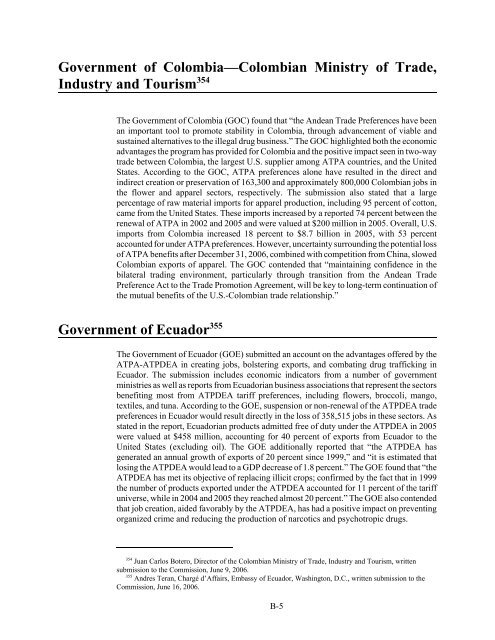The Impact of the Andean Trade Preference Act Twelfth ... - USITC
The Impact of the Andean Trade Preference Act Twelfth ... - USITC
The Impact of the Andean Trade Preference Act Twelfth ... - USITC
- No tags were found...
You also want an ePaper? Increase the reach of your titles
YUMPU automatically turns print PDFs into web optimized ePapers that Google loves.
Government <strong>of</strong> Colombia—Colombian Ministry <strong>of</strong> <strong>Trade</strong>,Industry and Tourism 354<strong>The</strong> Government <strong>of</strong> Colombia (GOC) found that “<strong>the</strong> <strong>Andean</strong> <strong>Trade</strong> <strong>Preference</strong>s have beenan important tool to promote stability in Colombia, through advancement <strong>of</strong> viable andsustained alternatives to <strong>the</strong> illegal drug business.” <strong>The</strong> GOC highlighted both <strong>the</strong> economicadvantages <strong>the</strong> program has provided for Colombia and <strong>the</strong> positive impact seen in two-waytrade between Colombia, <strong>the</strong> largest U.S. supplier among ATPA countries, and <strong>the</strong> UnitedStates. According to <strong>the</strong> GOC, ATPA preferences alone have resulted in <strong>the</strong> direct andindirect creation or preservation <strong>of</strong> 163,300 and approximately 800,000 Colombian jobs in<strong>the</strong> flower and apparel sectors, respectively. <strong>The</strong> submission also stated that a largepercentage <strong>of</strong> raw material imports for apparel production, including 95 percent <strong>of</strong> cotton,came from <strong>the</strong> United States. <strong>The</strong>se imports increased by a reported 74 percent between <strong>the</strong>renewal <strong>of</strong> ATPA in 2002 and 2005 and were valued at $200 million in 2005. Overall, U.S.imports from Colombia increased 18 percent to $8.7 billion in 2005, with 53 percentaccounted for under ATPA preferences. However, uncertainty surrounding <strong>the</strong> potential loss<strong>of</strong> ATPA benefits after December 31, 2006, combined with competition from China, slowedColombian exports <strong>of</strong> apparel. <strong>The</strong> GOC contended that “maintaining confidence in <strong>the</strong>bilateral trading environment, particularly through transition from <strong>the</strong> <strong>Andean</strong> <strong>Trade</strong><strong>Preference</strong> <strong>Act</strong> to <strong>the</strong> <strong>Trade</strong> Promotion Agreement, will be key to long-term continuation <strong>of</strong><strong>the</strong> mutual benefits <strong>of</strong> <strong>the</strong> U.S.-Colombian trade relationship.”Government <strong>of</strong> Ecuador 355<strong>The</strong> Government <strong>of</strong> Ecuador (GOE) submitted an account on <strong>the</strong> advantages <strong>of</strong>fered by <strong>the</strong>ATPA-ATPDEA in creating jobs, bolstering exports, and combating drug trafficking inEcuador. <strong>The</strong> submission includes economic indicators from a number <strong>of</strong> governmentministries as well as reports from Ecuadorian business associations that represent <strong>the</strong> sectorsbenefiting most from ATPDEA tariff preferences, including flowers, broccoli, mango,textiles, and tuna. According to <strong>the</strong> GOE, suspension or non-renewal <strong>of</strong> <strong>the</strong> ATPDEA tradepreferences in Ecuador would result directly in <strong>the</strong> loss <strong>of</strong> 358,515 jobs in <strong>the</strong>se sectors. Asstated in <strong>the</strong> report, Ecuadorian products admitted free <strong>of</strong> duty under <strong>the</strong> ATPDEA in 2005were valued at $458 million, accounting for 40 percent <strong>of</strong> exports from Ecuador to <strong>the</strong>United States (excluding oil). <strong>The</strong> GOE additionally reported that “<strong>the</strong> ATPDEA hasgenerated an annual growth <strong>of</strong> exports <strong>of</strong> 20 percent since 1999,” and “it is estimated thatlosing <strong>the</strong> ATPDEA would lead to a GDP decrease <strong>of</strong> 1.8 percent.” <strong>The</strong> GOE found that “<strong>the</strong>ATPDEA has met its objective <strong>of</strong> replacing illicit crops; confirmed by <strong>the</strong> fact that in 1999<strong>the</strong> number <strong>of</strong> products exported under <strong>the</strong> ATPDEA accounted for 11 percent <strong>of</strong> <strong>the</strong> tariffuniverse, while in 2004 and 2005 <strong>the</strong>y reached almost 20 percent.” <strong>The</strong> GOE also contendedthat job creation, aided favorably by <strong>the</strong> ATPDEA, has had a positive impact on preventingorganized crime and reducing <strong>the</strong> production <strong>of</strong> narcotics and psychotropic drugs.354Juan Carlos Botero, Director <strong>of</strong> <strong>the</strong> Colombian Ministry <strong>of</strong> <strong>Trade</strong>, Industry and Tourism, writtensubmission to <strong>the</strong> Commission, June 9, 2006.355Andres Teran, Chargé d’Affairs, Embassy <strong>of</strong> Ecuador, Washington, D.C., written submission to <strong>the</strong>Commission, June 16, 2006.B-5
















